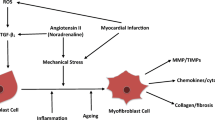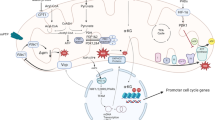Abstract
Cell loss is a common feature in the failing heart, and this contributes to the relentless progression seen in patients with heart failure. Apoptosis is one of the most common causes of cell loss in animals and humans with heart failure. There is increasing evidence that apoptosis, even while occurring in a low-grade manner, can mediate heart failure. Moreover, inhibiting apoptosis successfully prevents or attenuates heart failure in several animal models. More importantly, apoptosis is one of the few mechanisms that can be easily modulated using pharmacologic or gene therapy approaches. Animal data, obtained in the past few years, have proven the feasibility and success of this approach toward altering the natural history of heart failure. Human studies are pending, but a number of issues such as the type of inhibitor and its optimum timing/dose will need to be resolved before this becomes a reality. Nevertheless, these data will accrue over time, and antiapoptotic therapy is likely to emerge as an important form of heart failure therapy.
Similar content being viewed by others
References and Recommended Reading
American Heart Association: Heart Disease and Stroke Statistics-2003 Update. Dallas: American Heart Association; 2002.
Ho KK, Pinsky JL, Kannel WB, Levy D: The epidemiology of heart failure: the Framingham Study. J Am Coll Cardiol 1993, 22:6A-13A.
Pfeffer MA, Braunwald E: Ventricular remodeling after myocardial infarction. Experimental observations and clinical implications. Circulation 1990, 81:1161–1172.
White HD, Norris RM, Brown MA, et al.: Left ventricular end-systolic volume as the major determinant of survival after recovery from myocardial infarction. Circulation 1987, 76:44–51.
Rousseau MF, Konstam MA, Benedict CR, et al.: Progression of left ventricular dysfunction secondary to coronary artery disease, sustained neurohormonal activation and effects of ibopamine therapy during long-term therapy with angiotensin-converting enzyme inhibitor. Am J Cardiol 1994, 73:488–493.
Beltrami CA, Finato N, Rocco M, et al.: The cellular basis of dilated cardiomyopathy in humans. J Mol Cell Cardiol 1995, 27:291–305.
Nadal-Ginard B, Kajstura J, Leri A, Anversa P: Myocyte death, growth, and regeneration in cardiac hypertrophy and failure. Circ Res 2003, 92:139–150. This paper, with a number of others by this group, demonstrates the regenerative potential of cardiac myocytes, cells which were once considered terminally differentiated cells. This also suggests that a balance between cell loss and cell regeneration might determine the fate of cardiac mass in the failing heart.
MajnoG, Joris I: Apoptosis, oncosis, and necrosis: an overview of cell death. Am J Pathol 1995, 146:3–15.
Chandrashekhar Y, Narula JN: Cell death, cell survival, and the failing heart. Circ Res 2003, 92:710–714. This paper, with the study by Takemura and Fujiwara [12], provides a brief overview of issues associated with life and death in cells from the failing heart.
Kostin S, Pool L, Elsässer A, Hein S, et al.: Myocytes die by multiple mechanisms in failing human hearts. Circ Res 2003, 92:715–724.
Mani K, Kitsis RN: Myocyte apoptosis: programming ventricular remodeling. J Am Coll Cardiol 2003, 41:761–764.
Takemura G, Fujiwara H: Role of apoptosis in remodeling after myocardial infarction. Pharmacol Ther 2004, 104:1–16.
Cheng W, Kajstura J, Nitahara JA, et al.: Programmed myocyte cell death affects the viable myocardium after infarction in rats. Exp Cell Res 1996, 226:316–327.
Narula J, Haider N, Virmani R, et al.: Apoptosis in myocytes in end-stage heart failure. N Engl J Med 1996, 335:1182–1189. This was the first paper to demonstrate the occurrence of myocyte apoptosis in the failing human heart. It is accompanied by an editorial outlining the potential role of apoptosis in cell loss in heart failure. Many of the implied predictions in these two papers have come to be true.
Bialik S, Geenen DL, Ssson IE, et al.: The Caspase family cysteine proteases mediate cardiac myocyte apoptosis during myocardial infarction. Circulation 1997, 96:I-552.
Beltrami CA, Finato N, Rocco M, et al.: Structural basis of end-stage failure in ischemic cardiomyopathy in humans. Circulation 1994, 89:151–163.
Bing OH: Hypothesis: apoptosis may be a mechanism for the transition to heart failure with chronic pressure overload. J Mol Cell Cardiol 1994, 26:943–948.
Kang PM, Izumo S: Apoptosis and heart failure: a critical review of the literature. Circ Res 2000, 86:1107–1113. This is a very good overview of the apoptosis in heart failure. It is somewhat dated now but contains a significant amount of background data.
Kanoh M, Takemura G, Misao J, et al.: Significance of myocytes with positive DNA in situ nick end-labeling (TUNEL) in hearts with dilated cardiomyopathy: not apoptosis but DNA repair. Circulation 1999, 99:2757–2764. This paper challenges the use of the traditional method (TUNEL) of detecting apoptosis and makes the case for more rigorous methodology in identifying apoptosis.
Li Y, Takemura G, Kosai K, et al.: Critical roles for the Fas/ Fas ligand system in postinfarction ventricular remodeling and heart failure. Circ Res 2004, 95:627–636.
Garg S, Narula J, Chandrashekhar Y: Apoptosis and heart failure: clinical relevance and therapeutic target. J Mol Cell Cardiol 2005, In Press.
Communal C, Sumandea M, de Tombe P, et al.: Functional consequences of caspase activation in cardiac myocytes. Proc Natl Acad Sci USA 2002, 99:6252–6256.
LaugwitzKL, Moretti A, Weig HJ, et al.: Blocking caspase-activated apoptosis improves contractility in failing myocardium. Hum Gene Ther 2001, 12:1251–1263.
Moretti A, Weig HJ, Ott T, et al.: Essential myosin light chain as a target for caspase-3 in failing myocardium. Proc Natl Acad Sci U S A 2002, 99:11860–11865.
Chandrashekhar Y, Sen S, Anway R, et al.: Long term caspase inhibition ameliorates apoptosis, reduces myocardial troponin-I cleavage, protects LV function and attenuates remodeling in rats with a MI. J Am Coll Cardiol 2004, 43:295–301.
Narula J, Arbustini E, Chandrashekhar Y, Schwaiger M: Apoptosis and the systolic dysfunction in congestive heart failure. Story of apoptosis interruptus and zombie myocytes. Cardiol Clin 2001, 19:113–126.
Wencker D, Chandra M, Nguyen K, et al.: A mechanistic role for cardiac myocyte apoptosis in heart failure. J Clin Invest 2003, 111:1497–1504. This is one of the seminal papers that "nailed" the role of apoptosis in the genesis of heart failure. It contains quantitative data suggesting that even a low level of chronic apoptosis is sufficient to induce severe heart failure. This paper is accompanied by an excellent editorial about the role of cell death and regeneration in the failing heart.
Hayakawa Y, Chandra M, Miao W, et al.: Inhibition of cardiac myocyte apoptosis improves cardiac function and abolishes mortality in the peripartum cardiomyopathy of Galpha(q) transgenic mice. Circulation 2003, 108:3036–3041.
Yamamoto S, Yang G, Zablocki D, et al.: Activation of Mst1 causes dilated cardiomyopathy by stimulating apoptosis without compensatory ventricular myocyte hypertrophy. J Clin Invest 2003, 111:1463–1474.
Condorelli G, Roncarati R, Ross J Jr, et al.: Heart-targeted overexpression of caspase3 in mice increases infarct size and depresses cardiac function. Proc Natl Acad Sci USA 2001, 98:9977–9982.
Yamaguchi O, Higuchi Y, Hirotani S, et al.: Targeted deletion of apoptosis signal-regulating kinase 1 attenuates left ventricular remodeling. Proc Natl Acad Sci USA 2003, 100:15883–15888.
Frantz S, Ducharme A, Sawyer D, et al.: Targeted deletion of caspase-1 reduces early mortality and left ventricular dilatation following myocardial infarction. J Mol Cell Cardiol 2003, 35:685–694.
Engel D, Peshock R, Armstong RC, et al.: Cardiac myocyte apoptosis provokes adverse cardiac remodeling in transgenic mice with targeted TNF overexpression. Am J Physiol Heart Circ Physiol 2004, 287:H1303-H1311.
Moe GW, Marin-Garcia J, Konig A, et al.: In vivo TNF-alpha inhibition ameliorates cardiac mitochondrial dysfunction, oxidative stress, and apoptosis in experimental heart failure. AmJ Physiol Heart Circ Physiol 2004, 287:H1813-H1820.
Okamura T, Miura T, Takemura G, et al.: Effect of caspase inhibitors on myocardial infarct size and myocyte DNA fragmentation in the ischemia-reperfused rat heart. Cardiovasc Res 2000, 45:642–650.
Holly TA, Drincic A, Byun Y, et al.: Caspase inhibition reduces myocyte cell death induced by myocardial ischemia and reperfusion in vivo. J Mol Cell Cardiol 1999, 31:1709–1715.
Neviere R, Fauvel H, Chopin C, et al.: Caspase inhibition prevents cardiac dysfunction and heart apoptosis in a rat model of sepsis. Am J Respir Crit Care Med 2001, 163:218–225.
Hayakawa K, Takemura G, Kanoh M, et al.: Inhibition of granulation tissue cell apoptosis during the subacute stage of myocardial infarction improves cardiac remodeling and dysfunction at the chronic stage. Circulation 2003, 108:104–109. This paper, along with the study by Chandrashekhar et al. [25], was the first to demonstrate that pharmacologic inhibition of caspase activity reduces apoptosis and attenuates ventricular remodeling. This paper stresses the importance of inhibiting granulation tissue apoptosis, whereas others, including the study by Chandrashekhar et al. [25], show the importance of inhibiting cardiomyocyte apoptosis.
Author information
Authors and Affiliations
Rights and permissions
About this article
Cite this article
Chandrashekhar, Y. Role of apoptosis in ventricular remodeling. Curr Heart Fail Rep 2, 18–22 (2005). https://doi.org/10.1007/s11897-005-0003-5
Issue Date:
DOI: https://doi.org/10.1007/s11897-005-0003-5




